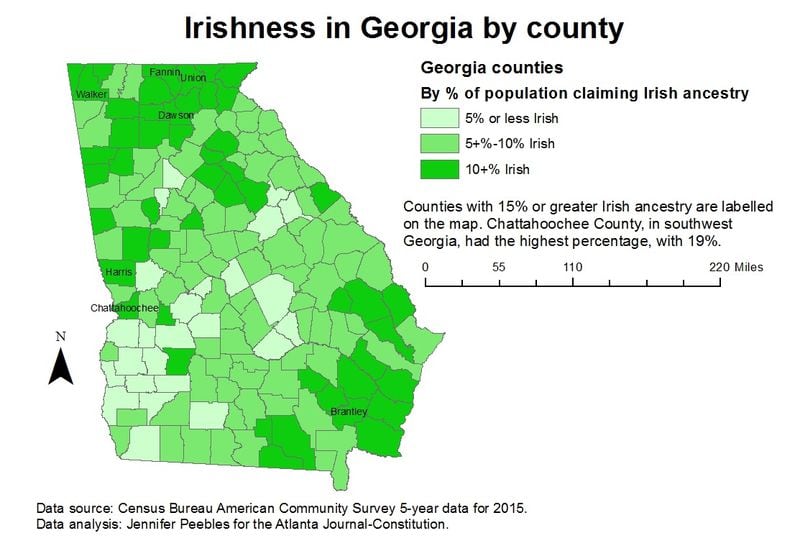With Saint Patrick's Day upon us again, it's a good time to check in on how the Irish are doing in Georgia.
The answer: They're still going strong.
More Georgians claim ancestry in Ireland than any specific foreign land other than England, according to the most recent estimates from the U.S. Census Bureau.
About 800,000 people in Georgia reported having Irish heritage, according to the five-year estimates from the Census' American Community Survey released just last year. More people claimed English bloodlines, but the Irish outstripped the No. 3-ranked foreign ancestry, the German descendants, by nearly 90,000 people.
While Savannah will party hearty every March 17, Irish descendants are all throughout Georgia, the data shows, though there are higher concentrations in areas of North Georgia and the counties along the coast.
And with increasing economic and academic links between Georgia and the Emerald Isle, "the relationship is not just historic -- the relationship is very much now, as well," said Howard Keeley, director of the Center for Irish Research and Teaching at Georgia Southern University.
The Irish began helping build Georgia from its earliest days.
Ships carrying Irish people began arriving in the new Georgia colony less than a year after James Oglethorpe and the first settlers arrived at Yamacraw Bluff on the ship the Anne and founded the new city of Savannah in 1733.
Like many arrivals in the New World, the Irish settlers who came to colonial Georgia were largely farmers who sought religious freedom and access to land ownership, Keeley said.
The "first dedicated Irish settlement in Georgia" was the Queensborough community, in what is now Jefferson County, in the 1760s-1770s, he said. Thousands of acres of land that had belonged to the Creek Indians around the Ogeechee River were offered to settlers willing to cross the Atlantic. The opportunity to start a new life in the Georgia colony was advertised in Ireland, Keeley said.
After the American Revolution, Queensborough would morph into the newly created town of Louisville, Georgia's first permanent state capital.
"That is really kind of lost," Keeley said of Queensborough's history. "We really should be telling that more, I feel." Researchers are in the early stages of doing archaeological work on the Queensborough site, he said.
In the early 1800s, Irish "diggers" or "ditchers" -- semi-skilled poor laborers -- dug canals in Augusta and built the railroads that would connect settlements further and further west, the professor said. They left their mark, such as by naming one new town Dublin. (Today, only about 1 in 25 people in Laurens County is Irish, the Census data shows.)
Likewise, many families living in northern Ireland who had Scottish roots also made their way to the new Georgia colony, and their descendants remain here today as the "Scotch-Irish" or “Scots-Irish.” About 122,000 Georgians claimed Scotch-Irish ancestry to the Census Bureau in the most recent data.
The potato famine of the mid-19th century sent waves of Irish immigrants to America, mostly to large cities up north, some came to southern cities like Charleston and Savannah, Keeley said.
Georgia's first city "has got a really good claim to be considered an Irish city," said Keeley, who himself is originally from Dublin (Ireland, not Georgia).
In the 1850s, shipping routes carrying immigrants to America were running from southeastern Ireland to Savannah, Keeley said. He said research suggests that as many as one in three white households in Savannah in 1860 were from Ireland -- "not just Irish, but Irish-born."
Emigration between County Wexford, Ireland, and Savannah was so great that today, more people in Savannah with Irish ancestry have Wexford roots than any other Irish county, Keeley said.
The Census data of today says about one person in 11 in Chatham County claims an Irish background, though that's unlikely to put a damper on the celebration there on Saint Patrick’s Day.
It might be surprising that the Georgia county today with the highest percentage of its population claiming Irish ancestry is nowhere near Savannah.
It's Chattahoochee County, population 12,000, near Columbus. About one person in five there reported having Irish in their blood, the Census figures show.
Seven Georgia counties have 15 percent or more population claiming Irish ancestry, the data shows, and four of them are in North Georgia -- Dawson, Union, Walker and Fannin counties.
Meanwhile, both Chattahoochee and Harris counties are outside Columbus, while the county seat of Brantley County is about a half-hour's drive east of Waycross.
The counties with the highest raw numbers of Irish descendants were, not surprisingly, Georgia's most populous counties: Cobb, Fulton, Gwinnett, DeKalb and Cherokee.
The counties with the lowest percentages of Irish descendants were Telfair, Clayton, Clay, Warren and Twiggs. Only about one person in 100 in Telfair County, in Middle Georgia, claimed to have Irish ancestry.







